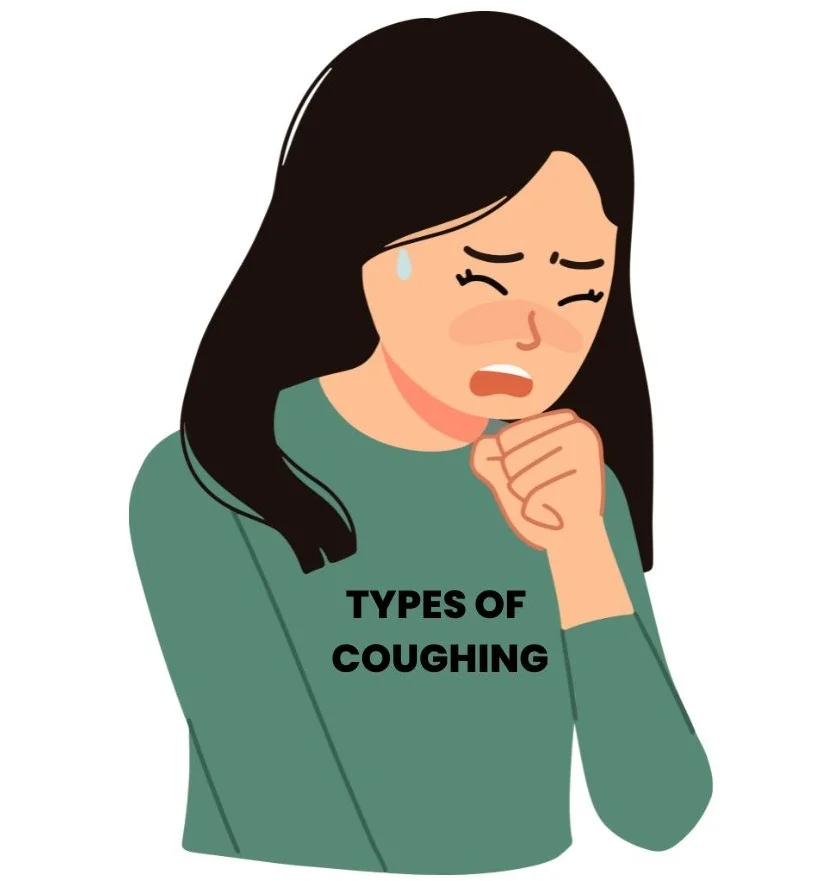Coughing is a natural reflex action that helps clear the throat and airways of irritants such as mucus, dust, smoke, or foreign particles.
It occurs when the body’s respiratory system reacts to an irritant, causing the muscles in the chest and throat to contract and force air out of the lungs with a sharp, often loud, sound.
Coughing can be voluntary or involuntary, and it is often a symptom of various conditions like colds, flu, allergies, or respiratory infections.
Coughing helps protect the lungs and airways by removing unwanted substances or irritants, and while it can be uncomfortable, it is an important defense mechanism of the body.
Coughing can present in various forms depending on the underlying cause, and understanding the different types help in diagnosing and treating conditions.
HERE IS A VERY INTERESTING POST ON HOW TO EXAMINE THE RESPIRATORY SYSTEM OF PATIENT.

Here are the common types of coughing:
Table of Contents
ToggleDry Cough
- Characteristics: This type of cough doesn’t produce mucus or phlegm. It often feels irritating or scratchy and is commonly triggered by inflammation in the airways.
- Causes: Can be due to viral infections (like a cold or flu), asthma, allergies, or environmental irritants such as dust and smoke.
- Example: Seen in early stages of respiratory infections, allergic reactions, or after exposure to irritants.
Productive (Wet) Cough
- Characteristics: A wet cough produces mucus or phlegm from the lungs. Patients may feel like they need to clear their throat or chest frequently.
- Causes: This type of cough is often associated with bacterial infections, bronchitis, pneumonia, chronic obstructive pulmonary disease (COPD), and can occur after viral infections.
- Example: Common in bronchitis and pneumonia, where the body is trying to expel mucus from the lungs.
Spasmodic Cough
- Characteristics: A sudden, intense series of coughs that may result in difficulty breathing.
- Often occurs in rapid succession or in fits (paroxysms) and may lead to gagging or vomiting.
- Causes: Typically seen in whooping cough (pertussis), asthma, or GERD (gastroesophageal reflux disease).
- Example: Seen in pertussis, where the cough sounds like a “whoop” due to rapid intake of breath between fits.
Barking Cough
- Characteristics: A cough that sounds like a seal’s bark.
- It is harsh and often accompanied by difficulty breathing.
- Causes: Common in croup, an infection of the upper airways, particularly in children.
- It can also be caused by laryngitis or subglottic swelling.
- Example: Seen in children with croup, which worsens at night or in cold air.
Chronic Cough
- Characteristics: A persistent cough lasting more than 8 weeks in adults (or more than 4 weeks in children).
- It can be dry or productive.
- Causes: Chronic coughs are often due to underlying conditions such as chronic bronchitis, asthma, post-nasal drip, GERD, or smoking.
- Example: Seen in COPD or in smokers with “smoker’s cough”.
Hacking Cough
- Characteristics: A short, frequent, often repetitive cough that is usually dry. It can be bothersome but not deep.
- Causes: Can be caused by mild viral infections, post-nasal drip, or irritation in the throat.
- Example: Common during early cold or flu stages.
Nocturnal Cough
- Characteristics: A cough that worsens at night, often preventing sleep.
- Causes: Often associated with asthma, GERD, or post-nasal drip.
- Lying flat can exacerbate these conditions by causing mucus or acid to irritate the throat.
- Example: Seen in asthmatic children or individuals with acid reflux.
Cough with Hemoptysis (Blood)
- Characteristics: This type of cough produces blood or blood-streaked phlegm.
- It may accompany other symptoms like chest pain or difficulty breathing.
- Causes: Serious conditions like lung infections, tuberculosis, lung cancer, or pulmonary embolism.
- Example: Seen in patients with tuberculosis or advanced lung cancer.
Nervous or Psychogenic Cough
- Characteristics: A habitual cough that is often dry and non-productive.
- It may occur frequently during the day but disappears during sleep.
- Causes: Often linked to stress, anxiety, or habit.
- There is no underlying physical cause.
- Example: Seen in children or adults with anxiety disorders or those under high levels of stress.
Asthmatic Cough
- Characteristics: Often dry and accompanied by wheezing and shortness of breath.
- Coughing fits may be triggered by exercise, allergens, or cold air.
- Causes: Triggered by asthma when the airways become inflamed and constricted.
- Example: Seen in individuals with asthma, especially during exposure to triggers like dust or pollen.
Cough from GERD
- Characteristics: A chronic, dry cough that often occurs after meals or at night due to acid reflux irritating the esophagus and airways.
- Causes: Caused by gastroesophageal reflux disease (GERD), where stomach acid flows back into the esophagus and throat, triggering a cough.
- Example: A common symptom in individuals with acid reflux who experience coughing after lying down.
Whooping Cough
- Characteristics: A severe, spasmodic cough that is often followed by a high-pitched “whoop” sound when the patient inhales after coughing.
- Causes: Caused by Bordetella pertussis bacteria, common in children but can affect adults as well.
- Example: Seen in patients with pertussis, especially young children who experience long coughing fits.
These different types of coughs help identify the underlying causes and allow for targeted treatment.
